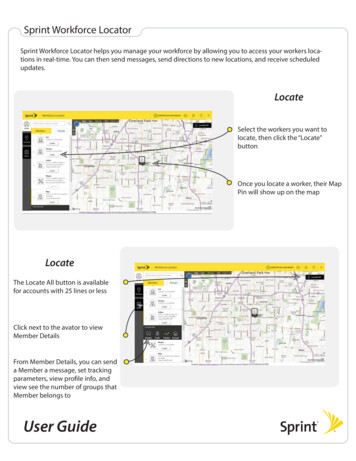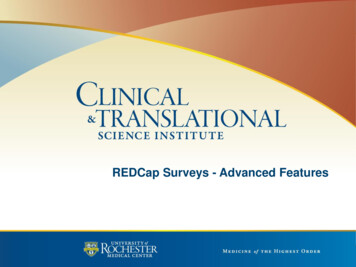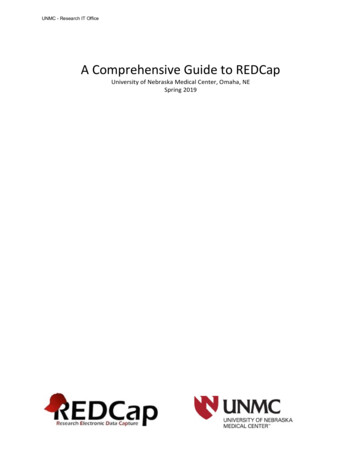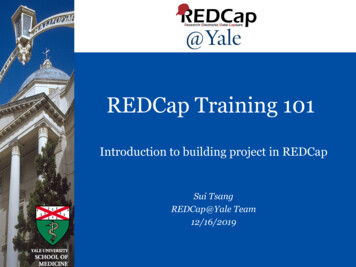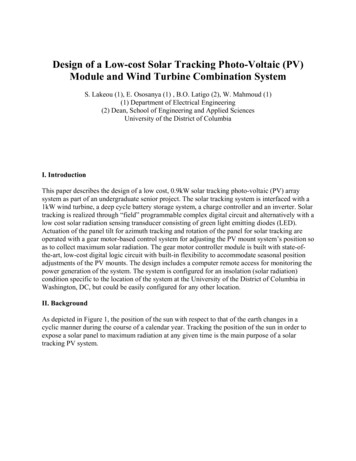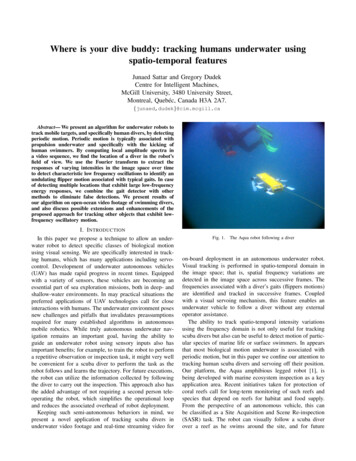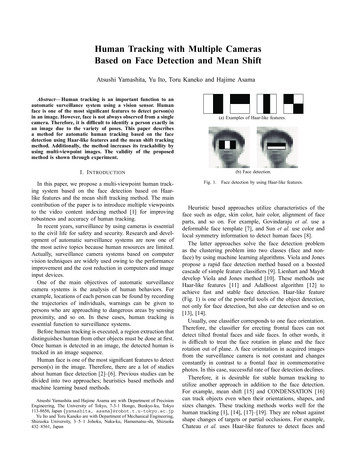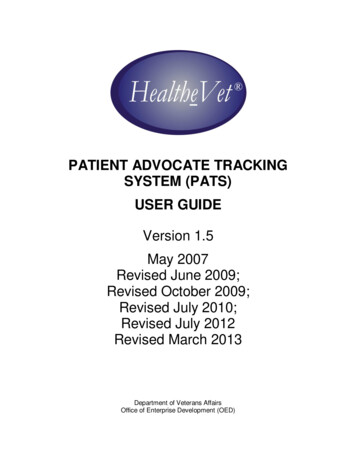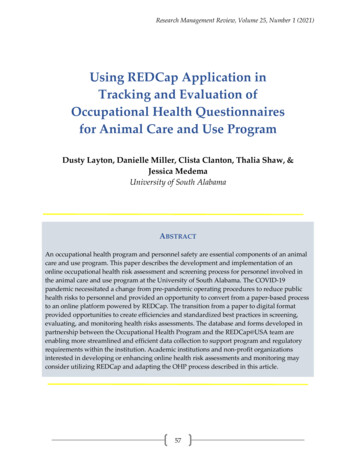
Transcription
Research Management Review, Volume 25, Number 1 (2021)Using REDCap Application inTracking and Evaluation ofOccupational Health Questionnairesfor Animal Care and Use ProgramDusty Layton, Danielle Miller, Clista Clanton, Thalia Shaw, &Jessica MedemaUniversity of South AlabamaABSTRACTAn occupational health program and personnel safety are essential components of an animalcare and use program. This paper describes the development and implementation of anonline occupational health risk assessment and screening process for personnel involved inthe animal care and use program at the University of South Alabama. The COVID-19pandemic necessitated a change from pre-pandemic operating procedures to reduce publichealth risks to personnel and provided an opportunity to convert from a paper-based processto an online platform powered by REDCap. The transition from a paper to digital formatprovided opportunities to create efficiencies and standardized best practices in screening,evaluating, and monitoring health risks assessments. The database and forms developed inpartnership between the Occupational Health Program and the REDCap@USA team areenabling more streamlined and efficient data collection to support program and regulatoryrequirements within the institution. Academic institutions and non-profit organizationsinterested in developing or enhancing online health risk assessments and monitoring mayconsider utilizing REDCap and adapting the OHP process described in this article.57
Research Management Review, Volume 25, Number 1 (2021)INTRODUCTIONIACUC protocol handling animal tissues,provide a healthy and safe workplace for alldirect contact with animals. Historically, thepersonnel exposed to animals in biomedicalOHP healthcare provider required mostresearch and/or teaching. The Guide for thepersonnel to obtain an in-person healthCare and Use of Laboratory Animals, 8thassessment as part of the risk assessmentedition (National Research Council of theprocess at a designated healthcare facility.National Academies, 2011), and PHS PolicyDuring the COVID-19 pandemic and(Office of Animal Laboratory Welfare, 2015)corresponding public health safety concernsmandate a safe working environment for(specifically social distance mandates andpersonnel involved in the animal care and“stay at home” orders), the OHP faceduse program within the institution. Thechallenges and could not continue with pre-Guide specifies that “hazard identificationpandemic operating procedures.and members of the IACUC who have noHigher education institutions mustDuring the public health pandemicand risk assessment” are essentialcomponents of an Occupational Healthresponse to COVID-19, many institutionsProgram (OHP) and that “health and safetyturned to REDCap (Research Electronicspecialists” should be involved in theData Capture) for health surveillanceevaluation of the OHP, hazards, andtracking, testing, and vaccination efforts,enrollee (National Research Council (US)including over 20 U.S. states using REDCapCommittee for the Update of the Guide forfor their vaccination enrollment plansthe Care and Use of Laboratory Animals,(Vanderbilt University, 2021). Utilized by2011). The University of South Alabama’sover 5,000 institutions in 141 countriesOHP is administered by the Office of(Vanderbilt University, 2021), REDCap is anResearch Compliance and Assuranceeasy-to-use and secure software application(ORCA). The Institutional Animal Care &developed by Vanderbilt University (HarrisUse Committee (IACUC) reviews OHPet al., 2009) and available via a consortiumduring semi-annual program reviews.model to any academic, non-profit, orBACKGROUNDgovernment partner wishing to adopt thesoftware. This consortium-based supportThe OHP covers persons having directmodel gives partner institutions access at noor indirect contact with animals to evaluatecharge to their own REDCap system housedhealth risks associated with occupationalon local institutional servers, but doesexposures. Individuals having indirectrequire that each institution has its owncontact with animals are facilityuser and IT support who manage localmaintenance workers located within animalinstallations of the platform and supporthousing areas, personnel listed on an58
Research Management Review, Volume 25, Number 1 (2021)local users of the software (Harris et al.,would be maintained, which meant2019). REDCap was developed to supportreducing in-person office visits whenclinical and translational research projectspossible yet still providing a proper risk-and is compliant with the Health Insurancebased provider assessment for researchPortability and Accountability Act (HIPAA)personnel. With this information in mind,required to protect individually identifiableORCA initiated preliminary discussionselectronic health information. Thewith USA’s COVID-19 Health SurveillanceUniversity of South Alabama (USA)team to learn more about the possible usesadopted REDCap in 2015. Still, the campusfor REDCap beyond COVID-19 contactComputer Center providing server supporttracing. After meeting with the Healthrequested that only de-identified healthSurveillance team, ORCA recognizedinformation be entered into the system,numerous benefits in using REDCap’swhich limited use for those within the USAelectronic data collection and managementHealth System needing to collect HIPAA-processes to replace the current OHP paper-protected information associated withbased system. ORCA then met with theindividuals. The second instance ofIACUC and presented information on whyREDCap was implemented within the USAREDCap would benefit the IACUC OHPHealth System on a HIPAA-compliantprogram.server in February 2020, just before USASince contact tracing is largely based ontransitioned to a work from home model forrisk assessment, ORCA suggested to themost campus employees in mid-March. TheIACUC as a best practice that REDCap besubsequent increased demand for REDCapused to evaluate potential risks(s)within the institution to support projectsassociated with working with animals,associated with COVID-19, including healthincluding a standardized health assessmentscreenings, contact tracing, testing andof personnel. ORCA recognized the benefitvaccination efforts, led to the formation ofin using REDCap to streamline processesan expanded group of designatedutilizing electronic forms for data collectionBiomedical Library staff called thewhile still effectively maintaining theREDCap@USA team to better supportintegrity of a risk-based approval processinstitutional REDCap users and projectdetailed in the OHP. In addition to usingbuilds.REDCap for data collection, associated OHPIn response to the COVID-19 pandemic,educational training materials can be linkedthe IACUC and ORCA decided that thethrough REDCap for enrolled participants.current OHP operational processes neededREDCap is designed for ease of use withto be modified. The IACUC and ORCAmultiple online and video resources forwanted to ensure the program’s integrityguidance. System-generated email59
Research Management Review, Volume 25, Number 1 (2021)notifications can be sent when records areAdditionally, REDCap will be used toadded, leading to labor-savingmonitor changes to relative risk, includingcommunications between the healthcarean annual health questionnaire required ofprovider and the IACUC office.Biosafety Level-3/Animal Biosafety Level-3personnel and a triennial healthREDCAP FOR COLLECTION OF OHPINFORMATIONquestionnaire for personnel exposed toanimals or animal products. TheseORCA began working with thedatabases have been specifically designed toREDCap@USA team in June 2020 tocollect health questionnaires and evaluateimplement this project. The REDCap@USAmedical histories. The use of REDCap isteam supports the development of REDCapexpected to streamline risk assessment andsurveys and databases for a wide range ofenrollment in OHP. To improveresearch, performance improvement, andcommunications between the healthcareprocess support projects within the USAprovider and the ORCA, the design of thecampus and health system. To recreate thedatabase includes various automated emailcurrent forms in a digital format andnotifications. For example, 60-day and 30-implement the changes requested byday reminders are sent to the enrolledORCA, REDCap team members consultedpersonnel, the healthcare provider, and thewith the Office of Research Compliance andORCA. It’s important to note that theAssurance, including the IACUCexchange of information among all partiesAdministrator, to better understand currentis done securely through the REDCapprocesses and reviewed existing paper-program, which is housed on a HIPAA-based procedures and tracking of OHPcompliant institutional server andenrollment status. An online platform forconfigured to meet IT security best practicessubmitting the OHP health questionnaire(Vanderbilt University, n.d.). REDCap alsowas then developed. The REDCap platformhas the capability to process identifiable,includes a process for reviewinganonymous, or pseudonymous participantinformation submitted to the IACUC Officedata, depending on project needs.by the healthcare provider and a trackingBENEFITS OF ELECTRONIC VS.PAPER-BASED DATA COLLECTIONmechanism to obtain healthcare providerdocumentation regarding work for specificlaboratory settings. The pitch for utilizingA paper health screening form wasREDCap was presented during a semi-filled out by employees, who were asked toannual program review and its use forprovide their contact information, employeeadministrating the OHP approved by theID, job title, department and supervisor’sIACUC.name, and email. The same information iscollected in digital format with the60
Research Management Review, Volume 25, Number 1 (2021)additional capability of validating emailuser rights do not allow access to the initialaddresses, phone numbers, and zip codeshealth screening, annual/triennial reviews,using the short text field type. Entry pointsor medical record request forms. Usinghave been added to collect the emailREDCap’s “piping” feature, contactaddresses of the employee and supervisor,information from the initial health screeningwhich are essential for the distribution ofform needed by the ORCA administrators isautomated alerts/notifications and surveyautomatically copied to the OHP Profiles(form) invitations. The alerts/notificationsform. The only information passed to thefeature automates at least ten points ofemployee’s supervisor is delivered in ancontact that previously would have beenemail which includes the employee’s nameperformed manually. Any informationand their clearance status. Relying oncollected via REDCap is only accessible toelectronic data collection reduces the risk ofthe ORCA administrators, medicalinadvertently exposing PHI compared toproviders, and REDCap administrators whothe paper-based collection methods, whilehave access to the project via their REDCapbeing able to mimic the look and feel of theaccount, which is secured with a usernamepaper forms with which employees areand password. The ORCA administrators’familiar.Figure 1. Section of the original paper enrollment form61
Research Management Review, Volume 25, Number 1 (2021)Figure 2. Electronic format of the section utilizing the matrix field type in REDCapIncorporating branching logic creates aThe use of branching logic also offers thereduced data entry load for employeesopportunity to capture more informationfilling out the initial health screening andthan would have been possible with aallows the employee to move through thespace-restricted paper form. To reduce theprocess more efficiently. Branching logicdata entry burden, information that hasmay be employed when fields or questionsalready been collected on the screeningare not needed for specific populations orform is pre-filled into subsequent forms.need to be hidden under certain conditions.62
Research Management Review, Volume 25, Number 1 (2021)Figure 3. Employee health clearance processIf the employee elects not to participate,to the healthcare provider email addressthey are automatically redirected to aand an alert is sent to the IACUCwaiver form, which also triggers aAdministrator. Annual and triennialnotification addressed to the Attendingreviews are set up with a similarVeterinarian. Once the employee submitsnotification process including links to thetheir initial health screening form, if themost recent forms that have been completedPhysician’s Clearance Form is notby the employee.submitted within 3 days a reminder is sent63
Research Management Review, Volume 25, Number 1 (2021)Figure 4. Record dashboard displaying instrument (form) statusFigure 5. Alerts sent based on answers to the screening formAutomatic invitations have been set up.reminder is activated when the clearanceWhen an employee is due to complete anform is completed but is scheduled to beannual or triennial evaluation, they willsent 300 calendar days later. If the reviewreceive an email with a unique link to theform is not completed within 30 days, anecessary form within their record. Thereminder email will be sent, with a secondconditions required for an invitation to beand final reminder 30 days later or 5 dayssent are the completion of the Initial Healthbefore the due date. This provides theScreening and the type of work for whichemployee with three months to submit thethe employee is cleared. The annual emailreview form.64
Research Management Review, Volume 25, Number 1 (2021)Figure 6. Conditional logic implemented to trigger automatic survey invitationA benefit of the REDCap automatedREDCap allows reports to be created usingemail system is that the burden ofas many or few variables from the project asmaintaining a database or reminders fordesired, and the reports can be tailoredannual and triennial review is lessened forusing basic filters or complex logic. Multiplethe IACUC administrator. REDCap’sreports can be created and convenientlyreports feature was used to create severalhoused on the left navigation pane withincustomized reports, which allow ORCA andthe REDCap project. Data can also bethe IACUC Administrator to browse a list ofexported to Excel or other statisticalemployees quickly. These dynamic reportssoftware packages such as SPSS, SAS, andare designed to be updated automatically inR.real-time each time they are viewed.65
Research Management Review, Volume 25, Number 1 (2021)Figure 7. Custom reports can be created, exported, and viewed in several waysAdditionally, a “Profile” form isfrom other forms, and the Shazam externalincluded in the project database wheremodule was used to display the form in acritical information about each employeeconcise and easy-to-read manner. This add-(for example, the date of their last review,on enhances the functionality and cosmeticany waivers, type of work for which theyappearance of the form without interferingare cleared, and an option to uploadwith the integrity of the data or how it isdocuments) are centralized for the use ofmanaged in the database. Shazam can beORCA and the IACUC Administrator.enabled for any REDCap project and allowsIndividual packages of software calledinstruments such as surveys and forms toexternal modules are available for REDCaphave custom layouts created by usingand can extend functionality,HTML tables to rearrange fields, enabling acustomization, and enhancements at bothdesign that better replicates the originalthe system and individual project levels.paper form.The “Profile” form employs data imported66
Research Management Review, Volume 25, Number 1 (2021)Figure 8. OHP Profiles form utilizing Shazam external module formatting capabilitiesDRIVERS OF SUCCESS ANDCHALLENGES FORIMPLEMENTATIONquestions/fields into the digital formatand reports in REDCap was approximatelyevolved several times, as these fields were65 hours. Critical components for success ininitially a forced-entry yes/no question.this transition from paper to digital formatThrough conversations between ORCA andincluded consistent and transparentthe REDCap@USA team, it was decided thatcommunication between ORCA andthere should be a ‘Not Sure’ option as manyREDCap team members. ORCA had a clearpeople may not recall every vaccinevision regarding the desired programreceived but may know one or some ofchanges, provided copies of paper formsthem. Also included was an optionalwith the edits wanted, and promptlyvaccination date field if personnel indicatedanswered questions regarding formattingthat they had received a vaccination butand conversion. The ability to clarify anycould not remember the exact date, as thisareas of confusion or misinterpretation ofwas anticipated as a potential barrier forthe information on the forms and flexibilitysubmittal of the form. PDF copies of thewith the re-formatting of specificoriginal OHP forms being adapted withinallowed for the enhanced design of theproject. For example, questions involvingpast vaccinations and dates receivedThe build time for the USA OHP forms67
Research Management Review, Volume 25, Number 1 (2021)REDCap was housed in a shared folder on auseful to document changes, for referral andGoogle Drive for project documentation.archival purposes over the life span of theHand-marked revisions of the paper formsproject.and subsequent iterations were particularlyFigure 9. Project documents shared in Google DriveChallenges in implementing the OHPTherefore, alternative tools, including printprocess from paper to digital formatand video tutorials regarding the OHPincluded those not uncommon in projectsprocess in REDCap, were necessary tothat contain multiple stakeholders withensure those utilizing the forms hadbusy schedules located in separateadequate training.locations. The project was initiated after theREDCap@USA team members are alsoinstitution had mandated work from homeavailable for individual user trainingpolicies for most, but not all, universitysessions and to answer questions as needed.personnel. Consequently, meetings wereWhile not all institutions utilizing REDCapheld via Zoom, with follow-uphave dedicated personnel available to takecommunications occurring primarily viaon the primary responsibility of projectemail. Training sessions for the healthcarebuilds, REDCap has extensive internalproviders and IACUC personnel were alsodocumentation, including a list of trainingplanned via Zoom. That platform allows forvideos that allow inexperienced users toscreen sharing, making online demos bothbecome familiar with system features.easy and recordable for later viewing.Additionally, a repository for REDCap dataHowever, a primary obstacle for thecollection instruments and forms istraining sessions was finding times whereavailable for download to those withinmost stakeholders could meet together.REDCap partner institutions, allowing for68
Research Management Review, Volume 25, Number 1 (2021)the easy adoption and adaptation ofpreviously vetted projects (Obeid et al.,2013; Vanderbilt University, 2021).Figure 10. Training videos available on REDCap platformWith reduced traveling to off-sitethe utilization of REDCap for the USA OHPlocations for office visits, streamlined dataprogram will reduce barriers for bothcollection, and improved communicationspersonnel and administrative offices.between research laboratory staff, theIACUC office, and the healthcare provider,LITERATURE CITEDHarris, P. A., Taylor, R., Minor, B. L., Elliott, V., Fernandez, M., O’Neal, L., McLeod, L.,Delacqua, G., Delacqua, F., Kirby, J., & Duda, S. N. (2019). The REDCap consortium:Building an international community of software platform partners. Journal of BiomedicalInformatics, 95, 103208. https://doi.org/10.1016/j.jbi.2019.103208Harris, P. A., Taylor, R., Thielke, R., Payne, J., Gonzalez, N., & Conde, J. G. (2009). Researchelectronic data capture (REDCap)—A metadata-driven methodology and workflowprocess for providing translational research informatics support. Journal of BiomedicalInformatics, 42(2), 377–381. https://doi.org/10.1016/j.jbi.2008.08.010National Research Council (US) Committee for the Update of the Guide for the Care and Use ofLaboratory Animals. (2011). Guide for the care and use of laboratory animals (8th ed.).National Academies Press (US). http://www.ncbi.nlm.nih.gov/books/NBK54050/69
Research Management Review, Volume 25, Number 1 (2021)Obeid, J. S., McGraw, C. A., Minor, B. L., Conde, J. G., Pawluk, R., Lin, M., Wang, J., Banks, S. R.,Hemphill, S. A., Taylor, R., & Harris, P. A. (2013). Procurement of shared datainstruments for Research Electronic Data Capture (REDCap). Journal of BiomedicalInformatics, 46(2), 259–265. i.2012.10.006Office of Animal Laboratory Welfare. (2015). Public Health Service (PHS) policy on humane care anduse of laboratory animals. Office of Animal Laboratory icy.htmVanderbilt University. (2021). How REDCap is being used in response to COVID-19 – REDCap.How REDCap Is Being Used in Response to COVID-19. https://projectredcap.org/covid/Vanderbilt University. (n.d.). REDCap general security overview. Vanderbilt /About-REDCap-Vanderbilt.pdfVanderbilt University. (2021). Library – REDCap. /Vanderbilt University. (2021). Partners – REDCap. REDCap. https://projectredcap.org/partners/70
The Guide for the Care and Use of Laboratory Animals, 8th edition (National Research Council of the National Academies, 2011), and PHS Policy (Office of Animal Laboratory Welfare, 2015) mandate a safe working environment for personnel involved in the animal care and use program within the institution. The
